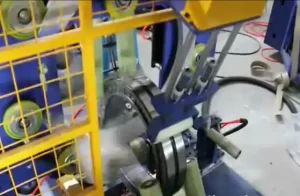Optimizing Bearing Protection: Customizing Your Automatic Vertical Stretch Wrapping Machine
Bearings are critical components in countless industrial applications, demanding precise handling and robust protection during storage and transit. Contamination, corrosion, and physical damage can compromise bearing integrity, leading to premature failure and costly downtime. An automatic vertical stretch wrapping machine provides essential protection, but a standard configuration may not address the unique challenges of your specific operation. Customizing this equipment is key to maximizing bearing protection, enhancing packaging efficiency, and integrating seamlessly into your production flow.
Why Standard Wrappers May Fall Short for Bearing Applications
While standard vertical stretch wrappers offer baseline functionality, bearing packaging often presents specific requirements:
- Variable Sizes and Weights: Bearings range from small, delicate components to large, heavy industrial units, each requiring different wrap forces and patterns.
- Surface Sensitivity: Preventing contamination and corrosion is paramount. The wrapping process must not introduce debris or damage protective coatings.
- Throughput Demands: High-volume production lines require wrapping cycle times that keep pace with upstream processes.
- Integration Needs: The wrapper must often interface with existing conveyor systems, robotic cells, or plant-wide data networks.
Tailoring the machine's features ensures it effectively addresses these challenges, moving beyond a one-size-fits-all approach.
Key Customization Areas for Enhanced Bearing Wrapping

Achieving optimal performance involves evaluating and potentially modifying several key machine aspects. Consider these critical areas when specifying or upgrading your bearing wrapping machine:
1. Precision Wrap Control: Tension, Speed, and Film Delivery
- Adjustable Wrap Tension: Essential for applying the correct containment force without crushing sensitive bearings or allowing heavy ones to shift. Look for systems offering precise, electronically controlled tension adjustment, potentially with multiple programmable levels for different product types.
- Variable Speed Control: Matching turntable or wrap arm speed to the bearing size and stability prevents load displacement during wrapping. Variable speed also allows optimization of cycle times.
- Optimized Film Delivery System: Customizing the pre-stretch carriage ensures maximum film yield (reducing costs and environmental impact) and consistent application. Consider power pre-stretch units capable of achieving high stretch ratios (e.g., 250% or more) suitable for high-performance films. Ensure the system handles the specific gauge and type of film best suited for bearing protection (e.g., cling properties, puncture resistance).
2. Advanced Automation and Control Logic
Programmable Logic Controllers (PLCs): A robust PLC is the brain of the operation. Custom programming allows for:
- Storing multiple wrap recipes for different bearing types/sizes.
- Implementing complex wrap patterns (e.g., reinforcing wraps at top and bottom).
- Automating cycle start/stop based on input from sensors or upstream equipment.
- Integrating safety functions and diagnostics.
Sensor Integration: Precise sensors (e.g., photoelectric eyes, laser measurement) automatically detect load height and profile. This enables the machine to adapt the wrap cycle in real-time, ensuring complete coverage without wasted film or operator intervention.

3. Enhanced Safety and Regulatory Compliance
Robust Guarding and Access Control: Custom safety cages, light curtains, and interlocked access doors are critical to protect operators, especially in automated lines. Ensure guarding meets or exceeds relevant standards (e.g., OSHA regulations, ANSI/PMMI B155.1).
Emergency Stop Integration: Strategically placed E-stops that halt all machine motion immediately are non-negotiable. Integration into the overall line control system is often necessary.
Compliance Verification: Ensure any customizations maintain the machine's compliance with applicable industry and regional safety standards (e.g., CE marking in Europe).
4. Durability for Demanding Environments
- Heavy-Duty Construction: Bearing handling often involves heavy loads and potentially oily environments. Opt for machines built with heavy-gauge steel frames, high-quality components (motors, gearboxes, and yes, even the machine's own bearings), and protective coatings.
- Tailored Maintenance Access: Customization can improve access to key components for routine maintenance and cleaning, reducing downtime and extending machine life. Consider features like swing-out film carriages or strategically placed access panels.
5. Seamless Integration with Production Systems
- Conveyor and Handling Compatibility: Ensure the wrapper's conveyor height, speed, and type (roller or chain) match your existing or planned material handling systems. Customization might involve specific conveyor lengths, widths, or control logic for smooth load transfer.
- Data Connectivity (IIoT/Industry 4.0): Modern operations benefit from data. Integrate capabilities for monitoring machine status, cycle counts, film consumption, and fault codes remotely. This data can feed into MES or SCADA systems for performance analysis and predictive maintenance. Look for compatibility with standard protocols like OPC UA or MQTT.
Evaluating the Value Proposition: Is Customization Cost-Effective?
While customization requires an initial investment, the long-term benefits often outweigh the costs:
- Reduced Product Damage: Optimal wrapping significantly lowers the risk of bearing damage during handling and shipping, reducing scrap and return rates.
- Lower Film Consumption: Precise tension control and high pre-stretch ratios minimize stretch film usage per load.
- Increased Throughput: Automated features and optimized cycle times boost packaging efficiency.
- Reduced Labor Requirements: Automation minimizes the need for manual intervention.
- Future-Proofing: Designing for scalability allows the machine to adapt to future production increases or changes in bearing types.
Conduct a thorough Return on Investment (ROI) analysis, factoring in these tangible savings against the customization costs.
Conclusion: Investing in Optimized Bearing Protection
Customizing an automatic vertical stretch wrapping machine is not merely an upgrade; it's a strategic investment in protecting valuable bearing assets and streamlining your packaging operations. By carefully considering wrap control, automation, safety, durability, and integration needs, manufacturers can configure a machine that delivers consistent, high-quality wrapping tailored precisely to their unique requirements. Engaging with experienced machinery suppliers who understand the nuances of bearing handling is crucial to developing a customized solution that enhances efficiency, reduces costs, and safeguards product integrity from the production line to the end-user.
